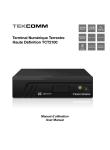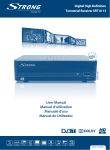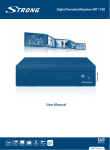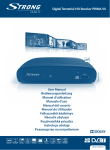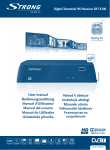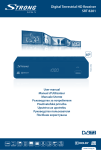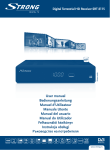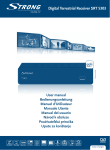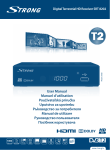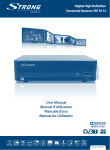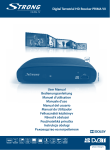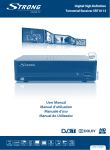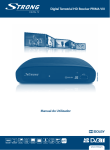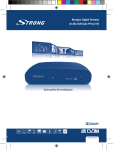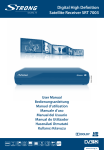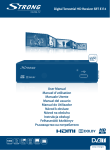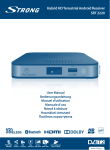Download user Manual Digital Terrestrial HD Receiver PRIMA VIII
Transcript
Picture similar Digital Terrestrial HD Receiver PRIMA VIII user Manual Licenses ANY USE OF THIS PRODUCT IN ANY MANNER OTHER THAN PERSONAL USE THAT COMPLIES WITH THE MPEG-2 STANDARD FOR ENCODING VIDEO INFORMATION FOR PACKAGED MEDIA IS EXPRESSLY PROHIBITED WITHOUT A LICENSE UNDER APPLICABLE PATENTS IN THE MPEG-2 PATENT PORTFOLIO, WHICH LICENSE IS AVAILABLE FROM MPEG LA, LLC, 6312 S. Fiddlers Green Circle, Suite 400E, Greenwood Village, Colorado 80111 U.S.A. THIS PRODUCT IS LICENSED UNDER THE AVC PATENT PORTFOLIO LICENSE FOR THE PERSONAL AND NONCOMMERCIAL USE OF A CONSUMER TO (i) ENCODE VIDEO IN COMPLIANCE WITH THE AVC STANDARD (“AVC VIDEO”) AND/OR (ii) DECODE AVC VIDEO THAT WAS ENCODED BY A CONSUMER ENGAGED IN A PERSONAL AND NON-COMMERCIAL ACTIVITY AND/OR WAS OBTAINED FROM A VIDEO PROVIDER LICENSED TO PROVIDE AVC VIDEO. NO LICENSE IS GRANTED OR SHALL BE IMPLIED FOR ANY OTHER USE. ADDITIONAL INFORMATION MAY BE OBTAINED FROM MPEG LA, L.L.C. SEE HTTP://WWW.MPEGLA.COM This product contains one or more programs protected under international and U.S. copyright laws as unpublished works. They are confidential and proprietary to Dolby Laboratories. Their reproduction or disclosure, in whole or in part, or the production of derivative works therefrom without the express permission of Dolby Laboratories is prohibited. Copyright 2003-2009 by Dolby Laboratories. All rights reserved. 3 Table of Contents 1.0 Introduction 1.1 Safety Instructions 1.2 Storage 1.3 Equipment Set-up 1.4 Accessories 1.5 Usage of external USB devices 2.0 Your Receiver 2.1 DEFAULT PIN: 1234 2.2 Front Panel 2.3 Rear Panel 2.4 Remote control 2.5 Installing the batteries 2.6 Using the remote control 3.0 Connections 3.1 Connecting to a terrestrial antenna 3.2 Connecting to TV with HDMI cable 3.3 Connecting to TV with SCART cable 3.4 Connecting to a Digital Audio Amplifier with S/PDIF 3.5 Connecting to a digital audio amplifier and TV using HDMI 3.6 Connecting to an analogue Audio Amplifier 3.7 Connecting a USB storage device 4.0 Starting up for the first time 5.0 Quick guide to using your receiver 6.0 Operation 6.1 Changing channels 6.2 Info Banner 6.3 Selection of audio language 6.4 Teletext 6.5 Subtitles 6.6 Timeshift 6.7 EPG (Electronic Programme Guide) 6.8 Instant Recording 7.0 Main Menu 7.1 Edit Channel 7.2 Installation 7.3 System Setup 7.4 Tools 7.5 Games 7.6 Media 8.0 Troubleshooting 9.0 Technical Specifications 4 5 5 5 6 6 6 7 7 7 7 7 8 8 9 9 9 9 9 9 10 10 10 11 11 11 12 12 12 13 13 13 13 14 14 16 17 19 21 21 24 25 1.0 Introduction 1.1 Safety Instructions DO NOT INSTALL YOUR RECEIVER: In a closed or poorly ventilated cabinet; directly on top of or under any other equipment; on a surface which might obstruct the ventilation slots. DO NOT EXPOSE THE RECEIVER OR ITS ACCESSORIES: To direct sunlight or any other equipment that generates heat; to rain or intense moisture; to intense vibration and to any shock which may cause permanent damage to your receiver or to any magnetic objects, such as loudspeakers, transformers, etc. Do not use a damaged power cord. It may cause a fire or an electric shock. Do not touch a power cord with wet hands. It may cause an electric shock. When the receiver is not used for a long period of time, you should unplug the power cord from the wall socket. Do not use alcohol or ammonia based liquids to clean the receiver. If you wish, you may clean your receiver with a soft lint-free cloth slightly made damp with a mild soap solution, and only after disconnecting from the mains voltage supply. Make sure no foreign objects fall through the ventilation slots because this could cause fire or an electric shock. Do not place any objects on top of the receiver because this might prevent proper cooling of the components inside. Safety Precautions Never try to open the receiver. It is dangerous to touch the inside of the receiver due to high voltages and possible electrical hazards. Opening the receiver will void the warranty of the product. Refer all maintenance or servicing to suitably qualified personnel. When you are connecting cables, be sure that the receiver is disconnected from the mains supply voltage. Wait a few seconds after switching off the receiver before you move the receiver or disconnect any equipment. It is a necessity that you only use an approved extension and compatible wiring that is suitable for the electrical power consumption of the installed equipment. Please ensure that the electrical power supply corresponds with the voltage on the electrical identification plate at the back of the receiver. If the receiver does not operate normally even after strictly following the instructions in this user manual, it is recommended to consult your dealer. 1.2 Storage Your receiver and its accessories are stored and delivered in a packaging designed to protect against electric shocks and moisture. When unpacking it, make sure that all the parts are included and keep the packaging away from children. When transporting the receiver from one place to another or if you are returning it under warranty conditions, make sure to repack the receiver in its original packaging with its accessories. Failing to comply with such packaging procedures could damage the product and void your warranty. 5 1.3 Equipment Set-up We recommend you consult a professional installer to set up your equipment. Otherwise, please follow the instructions below: Refer to the user manual of your TV and, if applicable, your antenna. Make sure that the HDMI cable and, if applicable, outdoor components are in a good condition. If you use TV SCART connection, use then well shielded SCART cable. This user manual provides complete instructions for installing and using this receiver. The symbols serve as follows. Warning Indicates warning information. Tips Indicates any other additional important or helpful information. MENU Represents a button on the remote control or the receiver. (Bold characters) Move to Represents a menu item within a window. (Italic characters) 1.4 Accessories Quick Installation Guide 1 remote control unit 2x batteries (AAA type) WarningThe batteries should not be recharged, disassembled, electrically shortcircuited, be mixed or used with other types of batteries. If rechargeable accumulators instead of batteries are going to be used (e.g. NiMH), we recommend using types with low self-discharge to ensure long time operation of your remote control. 1.5 Usage of external USB devices It is recommended to use USB 2.0 storage devices or higher. If your device is not compatible to USB 2.0 specifications, recording, playback and other multimedia functions of the receiver might not work properly. To ensure best performance of your USB storage device please format it via your receiver (through the menu “Media”) to FAT32 system. Other file systems are not supported by the receiver. However, it is possible to use already NTFS formatted disks. STRONG cannot guarantee compatibility with all types of USB storage devices. If you are going to use external USB HDDs (Hard Disk Drives), please consider that power specifications may exceed the supported output of your receiver (max.5 V/800 mA). If so, please connect your USB HDD to an according external power adapter. It is advised not to store important information on USB storage devices used with the receiver. Always make backups of data on your USB storage device before using it with this receiver. STRONG will not take responsibility for any loss of information or circumstances caused by loss of information. 6 2.0 Your Receiver 2.1 DEFAULT PIN: 1234 2.2 Front Panel 1. IR sensorPoint your remote control towards this sensor. 2. Mode indicatorRED indicates that the receiver is in STANDBY mode. GREEN indicates that the receiver is in OPERATING mode. 3. USBConnector for USB storage devices. Fig. 1 2.3 Rear Panel Fig. 2 1. ANT INTo connect to your antenna for reception of broadcasted signals. 2. ANT OUT To connect the terrestrial antenna signal to your TV set. This connection will allow you to watch digital terrestrial programmes depending on the tuner of your TV and local broadcast conditions 3. S/PDIF Coaxial To connect your receiver to a digital home theatre, AV receiver or digital audio amplifier. 4. HDMITo connect your receiver with your TV set using an HDMI cable. 5. TV SCART To connect your receiver with your TV set using a SCART cable. 6. Audio L/RTo connect your receiver to an analogue audio amplifier. 7. Power cordYour receiver requires a supply voltage of 220 – 240 V AC (Auto-selectable), 50/60Hz +/-5%. Please ensure the local power specification meets these requirements before connecting your receiver to the wall outlet. 2.4 Remote control Fig. 3 qSwitches the receiver On/Standby !Mutes all audio outputs of the receiver PG+/PG-Page up/down in all list modes DTV/VCRNo function INFOOpens the current channel information; 2x opens the current event information and 3x the signal information 6. VOL+/VOL-Increases/decreases the volume level 7. MENUOpens the main menu, in a menu you will get one step back 8. EXITExits from the menu or sub-menu 9. pqMenu Off: Change channel to next/previous. Menu On: Moves the cursor up/down. 10.tuMenu Off: Decreases/ increases the volume level. Menu On: Change settings for specific menus 1. 2. 3. 4. 5. 7 11.OKMenu Off: Displays the current channel list Menu On: Activates the highlighted menu item. 12.RECORDRecords the TV programme to the connected USB storage device 13.TIMESHIFTActivates the Timeshift function (Off/On) 14.0~9Enters a channel number in viewing mode or a value inside the respective menu 15.EPGOpens the EPG (Electronic Programme Guide) in TV mode 16.RECALLBack to previously watched channel 17.AUDIOOpens the audio language selection 18.TV/RADIOToggles between TV or RADIO mode 19.FAVOpens the favourite group selection 20.FILEOpens the Media Player list 21.TTXDisplays Teletext on the OSD (On Screen Display) 22.SUBTITLEShows a list of subtitle languages 23.56Fast rewind/fast forward 24.Coloured buttonsFor Multimedia and Teletext functions 2.5 Installing the batteries Fig. 4 Open the cover on the remote control and insert 2x AAA batteries into the compartment. Correct position of the polar diagram shows the batteries inside the compartment. 1. Open the cover. 2. Insert the batteries. 3. Close the lid. WARNINGThe batteries should not be recharged, disassembled, electrically shortcircuited, be mixed or used with other types of batteries. 2.6 Using the remote control Fig. 5 To use the remote control, point it towards the front of your receiver. The remote control supports a range of up to 5 meters distance to the receiver at an angle of up to approx. 30 degrees. NOTEManaging the receiver will be limited or not possible if there are obstacles between the remote control sensor (at the front panel of the receiver) and the remote control. Direct sunlight or very bright light can reduce or disturb the reception of the remote control signals. 8 3.0 Connections 3.1 Connecting to a terrestrial antenna Fig. 6 To receive broadcasted signals, your terrestrial indoor or outdoor antenna must be connected to the ANT IN connector on the back of the receiver. Use a properly shielded antenna cable and suitable connectors. The ANT OUT connector allows you to loop the antenna signal to a second receiver or TV set. Please consider that the looped signal might be too weak if you use an active antenna. NoteIf the signals at your location are too weak to receive proper signals with an indoor antenna, we recommend using an outdoor antenna which can be pointed towards the transmission tower. Ask your local dealer for more information. 3.2 Connecting to TV with HDMI cable Fig. 6 The TV set shall be connected with the receiver using a good quality HDMI cable. This connection gives the highest possible quality. 3.3 Connecting to TV with SCART cable Fig. 6 Your receiver is also equipped with a SCART connector; alternatively, the TV set can be connected to the receiver using a good quality SCART cable. 3.4 Connecting to a Digital Audio Amplifier with S/PDIF Fig. 6 By connecting your receiver to a digital amplifier or home theatre system, you can enjoy the best possible sound quality and multi-channel audio (depending on the broadcast). Connect your Digital Audio Amplifier or home theatre system with a suitable cinch cable to the S/PDIF connector on the back of the receiver. 3.5 Connecting to a digital audio amplifier and TV using HDMI Fig. 6 By connecting your receiver to the latest digital amplifiers or Home Cinema systems you will enjoy the best possible sound quality and multi-channel audio (depending on the broadcast). Connect the HDMI output of the receiver to an input of your amplifier, and then connect the HDMI output of the amplifier to your TV set. Select the correct input on your amplifier to watch and listen to programmes. 9 3.6 Connecting to an analogue Audio Amplifier Fig. 7 Use the 3.5 mm jack to connect your receiver to the analogue input of your Hi-Fi or audio amplifier with a 3.5 mm jack to RCA cable for achieving best possible analogue audio quality. 3.7 Connecting a USB storage device Fig. 8 Connecting a USB device to the unit allows you to playback movies, music and picture files which are stored on it. See chapter 7.5.1. Mediaplayer. Additionally, TV programmes can be recorded, put on hold (Timeshift) and played. See chapter 6. Operation. NoteIt is recommended to use USB 2.0 storage devices or higher for recording and playback of TV programmes or HD movies. NoteTimeshift/recording and playback only work properly when a fast USB storage device such as a USB2.0 HDD is connected to the receiver. Timeshift/recording and playback of HD content require a sufficient read/ write speed of the used USB storage device. 4.0 Starting up for the first time When you use your receiver for the first time, the Welcome “Easy install” menu appears. Use pq to move the highlight to the setting you wish to alter and use tu to change values. Start by selecting your language using tu. Once you have selected your language, press q to move the highlight to the next item and use tu to change. Language Here you can choose your language. Region: Select your region where this receiver is used. Subtitle: Select Normal to display subtitles per default, Select Hard of Hearing to show HoH subtitles per default. Select Off to hide subtitles per default.* Aspect Mode: Use this option to select the aspect ratio of your TV and the preferred conversion method. The options are: Auto (automatic detection of aspect ratio), 4:3 Panscan (Displays 16:9 widescreen broadcasts full screen on your 4:3 TV), 4:3 letterbox (black bars on top and under the picture on a 4:3 TV) and 16:9 (use this setting for 16:9 TV sets). Scan mode: Select All to store scrambled and free to air channels or select Free to store only free to air channels. Note: Scrambled channels cannot be viewed with this receiver. Connection: Use this option to adjust the established connection to your TV set. Select HDMI or TV SCART. *Availability of DVB/HoH subtitles depends on the broadcast. If subtitles are not supported, they can be activated via Teletext, if available. 10 When all settings have been made, move the highlight to OK and press OK to continue. NoteWrong region selection can lead to missing channels or channels being stored at wrong positions in the channel list. The receiver will now advance to the Aerial Adjustment screen. This part of the wizard is of great help when setting up your antenna system. Use pq to move the highlight to the setting you wish to alter and use tu to change values. The following settings are available: Antenna Power: Set to On if you use an active antenna. When set to On, 5 V will be present at the ANT IN connector of the receiver. Select Off for passive antennas. Beeper: Select On for an audible indication of signal reception. Off turns the beeper off. Channel No.: Select a channel that is known to carry a broadcast in your region. The Signal Strength and Signal Quality bars give a visual indication of the reception. Adjust your antenna to obtain maximum signal strength and quality. When all settings have been made, press OK to start scanning. The receiver will search for all available channels now. Once scanning is finished, the receiver switches to viewing mode. TIPIf the Welcome menu does not appear after switching on the receiver the first time, reset the receiver to factory settings by pressing the MENU button and selecting Load Factory Setting in the submenu Tools. (DEFAULT PIN: 1234). 5.0 Quick guide to using your receiver We at STRONG understand that you can’t wait to enjoy your new digital terrestrial HD receiver. The following quick guide will make you familiar with the basic operation of this device. We do, however, advice you to read the full manual to get the best performance from your receiver. To turn your receiver ON or to Standby, use the q button on the remote control. Choose a channel with pq. Alternatively, you can digit the channel number with the 0~9 buttons on the remote control or press OK in viewing mode to display the channel list. The volume can be adjusted with tu. 6.0 Operation 6.1 Changing channels Following ways are possible for changing channels with your new receiver: Via direct access using the 0~9 buttons. Via the channel list using OK and the PG+/PG- buttons. Via the pq buttons. 11 6.1.1 Direct access via 0~9 buttons To gain direct access to a certain channel, simply input its number with the 0~9 buttons on the remote control. Channel numbers can be up to four digits long. Entering a number with less than four digits is possible. Just wait a few seconds and your receiver will switch to the selected channel or press OK immediately after selecting the channel number. 6.1.2 Channel list Press OK in viewing mode to display the Channel List. Use pq in the channel list to highlight your channel of choice and press OK once to select the highlighted channel. Press OK again to leave the channel list mode. Inside the channel list it is possible to use the PG+/PG- buttons as well in order to scroll page-wise through the list. TIPUse tu to toggle between the All Channel list and favourite list(s) or press FAV in viewing mode for a list of the available favourite lists. 6.1.3 Using the pq buttons p switches to the next channel. q switches to the previous channel. 6.2 Info Banner While watching TV you can press the INFO button at any time to access current information about the channel and event*. Press INFO twice for extended EPG details about the current channel. Press INFO three times for technical details about the current channel. *Event information is displayed when available. Availability depends on the broadcast. 6.3 Selection of audio language Some channels support a choice of audio formats and/or languages. To select another audio stream, press AUDIO in viewing mode. A list with available audio streams will now be displayed. Use pq to select a stream and confirm with OK. The audio channel as stereo, mono, left and right can be selected with the tu buttons. 6.4 Teletext Your receiver includes a fully featured Teletext. To access Teletext, press the TTX button in viewing mode and use the 0~9 buttons to input the number of the page you wish to see. The coloured buttons of the remote control allow you to jump to selected pages directly, as indicated on the bottom of the Teletext screen. Use the pq buttons to select one page up or down, use the tu buttons to select subpages. Press EXIT or TTX to get back to viewing mode. 12 6.5 Subtitles Some channels support a choice of subtitle languages. Press SUBTITLE in viewing mode to display a list of available subtitle languages. Select your subtitle of choice with pq and press OK to confirm. Press EXIT to leave without making changes.* *Availability of DVB/HoH subtitles depends on the broadcast. If subtitles are not supported, they can be activated via Teletext if available. 6.6 Timeshift Timeshift allows you to pause live broadcasts and resume playback later. To activate this function set the Timeshift mode in the DVR Setting menu to on by selecting Pause. For details, see 7.6.3. Press 2 in viewing mode to activate Timeshift. The progress information banner appears on screen. Live TV keeps playing for moment and will then pause. Press u to resume Timeshifted playback. Press 3 to return to live TV. NoteTimeshift and its playback only work properly when a fast USB storage device such as a USB2.0 HDD is connected to the receiver. Timeshift and playback of HD content requires sufficient read/write speed of the used USB storage device . 6.7 EPG (Electronic Programme Guide) The Electronic Programme Guide is a very useful function that allows you to view event schedules and programme information and to mark events/movies for recording. To access the EPG, press the EPG button in viewing mode. Use pq to select a channel and tu to select an event. Press OK to display detailed information of the selected event. Use EXIT to quit the detailed information screen. Press RED to access further step functions. Use tu to select a step and OK to execute it. Press EXIT to quit the step function. Press GREEN to set a timer for a selected event. Refer to section 7.3.4 for details of the timer function. NoteAvailability of EPG data depends on the broadcast. 6.8 Instant Recording Your new receiver allows you to make an instant recording of the programme you are watching. Simply press RECORD to start the recording. To enter the duration for the recording, press RECORD again. Use the 0~9 buttons to enter the recording time and press OK to confirm. At the beginning of the recording a recording sign will be shown for a short while on the upper left corner of your TV screen. To stop the recording, press 3. Select Yes and press OK again to stop the recording. It is possible to make 2 recordings at the same time if they are broadcasted on the same frequency. You can access the Record Manager via the FILE button, and select Record by pressing the button 1. *Please connect a USB storage device with sufficient free space before you start a recording. 13 7.0 Main Menu The main menu gives you access to settings, multimedia functions and games. To access the main menu, press MENU in viewing mode. The main menu consists of the following sub menus: Edit Channel, Installation, System Setup, Tools, Games and Media. Throughout the main menu, MENU or EXIT can be used to get back to the previous screen. 7.1 Edit Channel Use pq to select Edit Channel and press OK or u to enter. Use pq to highlight the submenu of choice and press OK to select. Press EXIT or t to get back to the main menu. 7.1.1 TV Channel List In the Edit Channel menu select TV Channel List with pq and press OK to enter. Use tu to change the channel group (if you have already set up favourite groups). Select the channel of choice with pq. Press OK to view the selected channel in the preview box. 7.1.1.1 Adding channels to favourite lists Channels from the TV Channel List can be added to up to 8 different favourite groups. Press FAV in TV Channel List to access this function. The FAV sign on the top of the screen will move up to indicate that the favourite function is selected. Use pq to select a channel you wish to add to a favourite group. When the highlight is on the channel of your choice, press OK. A list with all available favourite lists will now pop up. Use pq to select the favourite list you wish to add the channel to and press OK, press EXIT to finalize the process. Favourite channels will be marked with . When all changes have been made, press EXIT twice. A confirmation banner will pop up. Select Yes to save the changes or No to discard. 7.1.1.2 Locking channels Locked channels can only be watched after entering the PIN code. (DEFAULT PIN: 1234) To lock or unlock a channel, press RED while in TV Channel List. Press pq to select a channel and press OK to lock or unlock it. You are asked to input the PIN code. (DEFAULT PIN: 1234 Locked channels will be marked with the symbol. Locking/unlocking multiple channels in one session is possible. When all changes have been made, press EXIT twice. A confirmation banner will pop up. Select Yes to save the changes or No to discard. 7.1.1.3 Skipping channels Channels marked with Skip will be skipped when zapping channels with the pq buttons. The channels will still be available from the channel list. To mark channels for skipping, press GREEN while in TV Channel List. Use pq to select a channel and press OK to mark or unmark it for skipping. Channels set for skipping will be marked with the symbol. When all changes have been made, press EXIT twice. A confirmation banner will pop up. Select Yes to save the changes or No to discard. 14 7.1.1.4 Moving channels To enable the Move function, press YELLOW while in TV Channel List. Use pq to select a channel and press OK to select it. Now you can move the selected channel up or down inside the channel list by using pq. When the channel is on the position of your choice, press OK again. The channel is now fixed on its new position. When all changes have been made, press EXIT twice. A confirmation banner will pop up. Select Yes to save the changes or No to discard. 7.1.1.5 Editing channels The Edit function allows you to Sort, Rename or Delete channels. To enter the Edit menu, press BLUE while in TV Channel List. The Edit Channel menu will appear. If you made changes in the previous menu, but haven’t saved them yet, you will be asked to do so now. Sort Press RED to enter the Sort menu. Use pq to select sorting method and press OK to confirm. Possible methods are: Name (A-Z): Sorting in alphabetical order from A to Z. Name (Z-A): Sorting in alphabetical order from Z to A. Free/Scramble: First in the list will be Free-To-Air channels. Lock: All unlocked channels will placed first in the list. Default: Sorting by searched Order (from lowest to highest frequency or by LCN numbering). Rename Press GREEN in Edit Channel to enable the Rename function. The Rename sign will move up to indicate that Rename is selected. Use pq to highlight a channel and press OK to select it. A text field will now pop up at the right of the screen. Use tu pq to select characters and enter them with OK. When you have finished editing, press BLUE to enter the changes. When all changes have been made, press EXIT twice. Select Yes to save the changes or No to discard. Delete Press BLUE in Edit Channel to enable the Delete function. The Delete sign will move up to indicate that Delete is selected. Use pq to highlight a channel and press OK to mark it for deletion. When you have marked all channels you wish to delete, press EXIT twice. A confirmation banner will be displayed. Select Yes to delete the marked channels or No to cancel. 7.1.2 Radio Channel List Basically, the operation of the Radio Channel List is the same as in the TV Channel List. The only difference is that in Radio Channel List there is no video information, so it will always display the radio background on the preview screen. 15 7.1.3 Delete all Use this menu to delete all stored channels. Select Delete All with pq and press OK. The receiver asks you to enter the pin code. (DEFAULT PIN: 1234). Inside the confirmation window select Yes with tu and press OK to delete or select No to cancel. Warning!The Delete all function will permanently delete all current channels and all favourite lists from your receiver, and you are not able to leave the menu until you search for channels again. 7.1.4 Rename Favourite list This menu allows you to personalize the names of the 8 available favourite lists. Use pq to select Rename Favourite List from the Edit Channel Menu and press OK to proceed. The names of all groups are now displayed. Select a favourite group with pq and press OK to edit its name. A text field will now pop up at the right of the screen. Use tu pq to select characters and enter them with OK. When you have finished editing, press BLUE to save the changes. When all changes have been made, press EXIT twice to leave this menu. 7.2 Installation 7.2.1 Auto Scan Use pq to select Installation and press OK or u to advance. Select Auto Scan with pq and press OK to enter. Use tu to toggle between Yes or No. When FTA Only is set to Yes, scrambled channels won’t be stored in the channel list. Use pq to highlight Search. Now press OK to start the auto scan. The receiver will store all found channels in the channel list. 7.2.2 Channel Scan Use pq to select Installation, press OK or u to advance. Use pq to select Channel Scan and press OK to enter. Use tu to toggle between the available scan modes: By Channel and By Frequency. If By Channel is selected, use the cursor buttons to select Scan Band and Channel No. If By Frequency is selected, use the cursor buttons to select Frequency and Bandwidth. Highlight Search and press OK to start scanning. Newly found channels will be added to the channel list. 7.2.3 Antenna Power Use pq to select Installation, press OK or u to advance. Use pq to select Antenna Power and press OK to enter. Set to On if you use an active antenna. Select Off for passive antennas. When set to On, 5 V will be present on the ANT IN connector of the receiver. Press EXIT to leave the Antenna Power menu. 16 7.2.4 LCN (Logical Channel Numbering) If LCN (Logical Channel Numbering) is activated and an LCN signal is provided by the operator, channels will be stored in the operator defined order. Set LCN to On to activate the operator defined channel numbering or Off to store channels in the found order. This function only applies when a new channel search is performed. 7.3 System Setup This menu allows you to manage the system settings of your receiver. It consists of the following sub-menus: Language, TV System, Local Time Setting, Timer Setting, Parental Lock, OSD Setting and Auto Standby. Press pq to highlight the menu of choice and press OK advance to the next screen. Use pq to move the highlight to the setting of choice. Values can be changed with tu. Press EXIT to leave. 7.3.1 Language This menu allows you to set up your language preferences. Language: Use tu to select the language for the On Screen Display. First Audio: Use tu to select Audio language. Second Audio: Use tu to select a language that will be played when the language selected at First Audio isn’t available. Subtitle Language : Use tu to select the preferred subtitle language. Teletext: Use tu to select the preferred Teletext language (when available). Subtitle: Use tu to select the preferred subtitle type to be displayed automatically. Select Normal, Hard of Hearing or Off* *Availability of DVB/HoH subtitles depends on the broadcast. If subtitles are not supported, they can be activated via Teletext if available. 7.3.2 TV System Use this menu to match your receiver to your TV set. The following settings are available: Video Resolution: Use this option to select the video resolution of your TV screen. The options are: By Source (automatic detection of video resolution offered to the receiver), By Native TV (automatic detection of maximal resolution of TV screen), and manual selections 480i, 576i up to 1080p. Use a setting that matches the specifications of your TV. After a selection is made, you will be asked to confirm. Selection above 576i is only applicable on HDMI output. Aspect Mode:Use this option to select the aspect ratio of your TV and the preferred conversion method. The options are: Auto (automatic detection of aspect ratio), 4:3 Panscan (Displays 16:9 widescreen broadcasts full screen on your 4:3 TV), 4:3 letterbox (black bars on top and under the picture on a 4:3 TV) and 16:9 (use this setting for 16:9 TV sets). Connection: Use this option to select the connection to your TV set. Select HDMI or TV SCART. If connection type HDMI is selected, then only the CVBS signal is available on the TV SCART. Digital Audio Output: Toggles between PCM and Bitstream output. When PCM is selected, all digital audio will be converted to stereo audio. Bitstream enables you to listen or 17 transfer Dolby® Digital/Dolby® Digital Plus* audio to the TV via HDMI or to a Home entertainment system (for example) through coaxial S/PDIF. Note:Dolby® Digital Plus* is only available on the HDMI output. *Dolby and the double-D symbol are registered trademarks of Dolby Laboratories 7.3.3 Local Time Setting Here you can set up your region and time zone. Region: Use tu to select the region you live in. GMT Usage: Set to By Region for broadcaster defined time, User Define to select manual a GMT zone or to Off to input time and date manually. GMT Offset: Allows you to adjust your time zone. This option is only available when GMT Usage is set to User Define.The GMT Offset range is "-11:30 ~ +12:00", increasing by half hours progressively. The cities matching the set GMT Offset are displayed at the bottom of the screen. Daylight Saving: Select On to add one hour for summer time. Date: Date and Time settings are available only when GMT Usage is set to Off. Use the 0~9 buttons to enter the date. Press EXIT to proceed. Time: Date and Time settings are available only when GMT Usage is set to Off. Use the 0~9 buttons to enter the time. Press EXIT to proceed. Time DisplaySelect On to display time on screen, Off to remove. 7.3.4 Timer Setting This menu allows you to set up to 8 timed events for recording or waking up the receiver. Use pq to select Timer Setting from the System Setup menu and press OK to enter. The receiver will display a list with 8 timers, followed by their respective status. Select the timer you wish to set or change with pq and press OK to proceed. The timer setup menu will now be displayed. The following settings are available: Timer Mode: Choose between Off the timer is inactive, Once, Daily (the timer will be executed every day, same time) or Weekly (the timer will be executed every week, same day, same time) and Monthly (the timer will be executed every month, same day, same time). Timer Service: Choose between Channel (the timer will wake up the receiver) or Record (Timer will start recording the scheduled event). Wakeup Channel:Use tu to select the channel the timer will wake up with. Wakeup Date: Use the 0~9 buttons to enter the date for the timed event. Wakeup Time: Use the 0~9 buttons to enter the starting time. Duration: Use the 0~9 buttons to enter the duration of the timer. When all settings have been made, use pq to move the highlight to Save and press OK to confirm. To quit the timer without saving your settings, move the highlight to Cancel. 18 7.3.5 Parental Lock This menu allows you to protect the installation menu and/or channels with a PIN code. You can also enter a new PIN code in the Parental Lock menu. Use pq to select Parental Lock from the System Setup menu and press OK to proceed. You will be asked to enter your PIN code. (DEFAULT PIN: 1234) Menu Lock: Locks the installation menu. You can set Menu Lock to On or Off. Parental Rating: Choose between: Off, 4 years and up to 18 years. Channels with a parental rating above the chosen age will be protected with a PIN code (if available in your local broadcast.) New Password: Enter your new PIN code (4 digits) here. Confirm Password: Re-enter your PIN code here to confirm. 7.3.6 OSD Setting This menu allows you to change settings for: OSD Timeout and OSD Transparency. OSD Timeout: Sets the duration time of on screen banners and messages remove. The range is 1~10 seconds or Always On. OSD Transparency: To set the OSD transparency from Off ~ 40% with 10% steps. Load Default OSD Setting: Press OK to clear all OSD settings and reset to default values. 7.3.7 Auto Standby Auto Standby is a new feature that helps you reducing power consumption. When set to 30Min/1 Hour/2 Hours or 3 Hours, the receiver will switch to standby if it doesn’t receive any commands during this time. Set Auto Standby to Off to deactivate the automatic standby function. 7.4 Tools Press MENU in viewing mode to enter the Main Menu. Select the Tools submenu with pq and press OK or u to enter. Use pq to highlight the submenu of choice and press OK proceed. Press EXIT to leave. 7.4.1 Information This submenu shows receiver specific information such as hardware version and software version. It also displays our web address www.strong.tv. Please have the Information screen on hand when you call our hotline. The person who answers your call might ask for the information given in this screen. 7.4.2 Load Factory Settings This option allows you to reset the receiver to factory settings, which clear all stored channels. Warning! By resetting your receiver to factory default, all your settings and stored channels will be permanently deleted. Please use this option with care. Use pq to select Load Factory Settings in the Tools menu and press OK. You are asked to input your PIN code. Input the correct PIN code using the 0~9 (DEFAULT PIN: 1234). A confirmation window is displayed. Select Yes to return to factory settings. Select No to cancel. 19 Press EXIT to leave. 7.4.3 S/W Upgrade by OTA This receiver is equipped with an Over The Air software upgrade function. An Over The Air update might not be available in your region. Please visit our website www.strong.tv or contact your local service hotline for more information about this option. 7.4.4 Upgrade by USB This feature allows you to upgrade receiver software via the USB port. When new software is available for your receiver, it can be downloaded from our website www.strong.tv. Place the software file (unzipped) in the root directory of your USB storage device (HDD, memory stick etc.) and connect the device to the USB port of the receiver. Select Upgrade by USB from the Tools menu and press OK to proceed. The upgrade menu will now be displayed. Use pq to select Update Mode and choose option Allcode. Use pq to select Upgrade File and choose the file containing the latest and correct software. When all settings have been made, move the highlight to Start and press OK to start the upgrade process. After a few seconds, the receiver asks: “Are you sure to burn flash?”. Select Yes to finalize the upgrade or No to quit without upgrading. Note:If, after a software upgrade, the receiver should behave in an unexpected way, please perform a factory reset as well. See chapter 7.4.2. Warning!After an update the receiver restarts automatically. During the upgrade process NEVER disconnect the receiver from the mains or switch off the power! Doing so might damage your receiver and will void warranty! 7.4.5 Channel Dump and Load function This feature allows you to load a channels list quickly and use a channel list that previously was created on this (backup) or another receiver from the same model via the USB port. This is useful when more receivers have to be installed in the same region, thus omitting a full scan and (optional) sorting of channels. It is also useful as a backup for your own unit. Channel Dump function (backup to USB) Have a storage device connected to the USB port of the receiver. Select Upgrade by USB from the Tools menu and press OK to proceed. The upgrade menu will now be displayed. Use pq to select Update Mode and choose the option Dump channel list. Use pq to select Upgrade File. A DataBase file name containing date and time will be presented, format DBYYYYMMDDHHMM (DateBaseYearMonthDateHourMinute.udf). Use pq to select Start and press OK to proceed. The channel list and favourites will be saved. 20 Update Channel list function (read from USB) Have the storage device connected to the USB port of the receiver, containing a previously made channel list on this unit or another of the same model. Select Upgrade by USB from the Tools menu and press OK to proceed. The upgrade menu will now be displayed. Use pq to select Update Mode and choose the option Update Channel list. Use pq to select Upgrade File. Select the correct database file name, format DBYYYYMMDDHHMM (DateBaseYearMonthDateHourMinute.udf). Use pq to select Start and press OK to proceed. Confirm the upgrade with OK to proceed. WarningOld channel list and favourites will be overwritten. After completion, the unit will reboot and come back with the first channel in the new channel list. 7.4.6 Auto-update OTA If set to On the unit will check automatically at the moment of going to stand-by for an Over The Air software upgrade. An Over The Air update might not be available in your region. Please visit our website www.strong.tv or contact your local service hotline for more information about this option. 7.5 Games Your receiver is equipped with two games which can be played on your TV screen using the receiver remote control. Use pq to select Games from the Main menu and press OK or u to proceed. Select one of the available games (Othello or Sudoku) using pq and press OK to start the game. Follow the directions on screen. Press EXIT to quit a game. 7.6 Media The Media menu consists of the following submenus: Media Player, HDD Information, DVR Setting and Remove USB device safely. Use pq to highlight the menu of choice and press OK to enter. Press EXIT to quit. 7.6.1 Media Player This function allows playback of different kind of files from the connected USB storage device. In the Media menu, select Media Player and press OK to enter this menu. When entering the media player, the highlight is on the USB storage device. Press q and OK to open the directory respectively its folders/subfolders. First select which files you like to play back. Press 1 to switch between Video/Record/Music or Image. Press pq to select a file or folder and then press OK to open the folder/subfolder (if applicable) or start playback of the file. Press the EXIT button to exit. Use the buttons like described below in order to choose functions during the different playback modes (like described in the help banner below): Video: INFO:Press the INFO button to set repeat mode. The options are repeat folder folder icon/repeat once 1 or no repetition (no icon shown). 21 1:During the playback of a movie with external subtitles, press 1 to enter the subtitle menu. In this menu you can select size and colours of your preference. 2:Press 2 to open the Sort menu. You can sort by Name/Time or Size. 7:Press 7 to open the Edit menu. This menu allows accessing the following functions by entering the number: rename 4, copy 5, delete 6, create folder 7. EXIT: One step back or leave the folder and quit the function. Record: 2:Press 2 to enter a new name for the selected recording. 3:Highlight the recording that you want to lock. After pressing 3 you will be asked to input your PIN code. DEFAULT PIN: "1234". After entering your PIN code, the recording is locked. If you want to unlock the recording again, press 3 again. 4:Press 4 to mark the recording you want to delete. By selecting the same recording and pressing 4 again you can remove the delete marker again. Press EXIT to delete. EXIT: One step back or leave the folder and quit the function. Music: 4: Press 4 to open a previously created play list. Then you can select the music file that you want to add your play list by pressing 5 (a single file will be added to the play list) or 6 (all files of this directory/folder will be added to the play list). 5:Press 5 to add a file to the playlist. A favourite icon will be shown next to the file. 6: Press 6 to add all files of this directory/folder to the play list. Press 6 again to delete all files from the play list. 7:Press 7 to open the Edit menu. This menu allows access to the following functions by entering the number: rename 4, copy 5, delete 6, create folder 7. 2:Press 2 to open the sort window. You can sort by Name/Time/Size and Favourite. INFO:Press the INFO button to set repeat mode. The option is Repeat Folder/ Random Folder/Repeat One. EXIT: One step back or leave the folder and quit the function. Image: 4:Press 4 to open a previously created play list. Then you can select the image file that you want to add your play list by pressing 5 (a single file will be added to the play list) or 6 (all files of this directory/folder will be added to the play list). 5:Press 5 to add a file to the play list. A favourite icon will be shown next to the file. 6:Press 6 to add all files of this directory/folder to the play list. Press 6 again to delete all files from the play list. 7:Press 7 to open the Edit menu. This menu allows access of the following functions: rename 4, copy 5, delete 6, create folder 7. 2:Press button 2 to open the sort window. You can sort by Name/Time/Size and Favourite. 22 INFO:Press INFO to access slideshow settings. You can change the slide time and slideshow repetition. 3:Press 3 to show the files in a preview of 3x3 pictures. EXIT: One step back or leave the folder and quit the function. 7.6.2 HDD Information This option shows relevant information about the connected USB device. In this menu you can also format your USB storage device and setup the recording type. Select HDD Information in the Media menu and press OK to enter. Now you will see all details as Free and the used Recording Sizes and the used file system. Press the YELLOW button Format to format the connected USB device. Please, enter your PIN code to access this menu and press OK to start formatting. Warning!Formatting will permanently delete ALL data stored on the connected device. Please make a backup copy of all data you wish to keep before entering the HDD Format menu. STRONG cannot be held responsible for loss of data from USB devices used with this receiver. Press OK to proceed, select FAT or Cancel, or press EXIT to leave without formatting. Press BLUE DVR Set to select recording type. Select REC & TMS to store recordings and Timeshift copies to your HDD. Select Record to store only recordings to your HDD. Select Timeshift to switch recordings OFF. Only the Timeshift function is active. NoteIt is possible to use USB storage devices already formatted in NTFS. Press EXIT to leave this menu. 7.6.3 DVR Setting This menu allows you to configure settings for Timeshift, recording and playback. Select DVR Setting in the Media menu and press OK to enter. Use pq to move the highlight and tu to change settings. Timeshift:Select between Auto, Pause or Off. When Timeshift is set to Auto it will automatically start every time after tuning to a channel. When Timeshift is set to Pause it will start only after pressing the YELLOW/2 button. Select Off to deactivate Timeshift. Step to: 30 sec to 30 min. Set the time step you like to jump forward to by pressing 4 during playback of recorded files. This only works when the info banner is displayed on screen. If it is not, press INFO. Timeshift to Record:If set to On the timeshifted part will be included in your recording when you start to record the current programme. PS Record:Select between On or Off. When Off is selected, recordings will also include subtitles and Teletext (when available). Record to PS mode On allows recordings without these extras and will need less space on your USB device. Press EXIT to leave this menu. 23 7.6.4 Remove USB device safely Select Remove USB device safely from the tools menu and press OK. The receiver will display a message indicating that you can safely remove your storage device from the receiver. NoteAfter performing this function, the USB device is no longer accessible from your receiver. To gain access to your storage device again, re-insert it or switch the receiver to standby and on again. 8.0 Troubleshooting There may be various reasons for abnormal operation of the receiver. Check the receiver according to the procedures shown below. If the receiver does not work properly after checking it, please contact your dealer or the local Service Hotline. Do NOT try to open or disassemble the receiver. It may cause a dangerous situation and warranty will be void. Problem Possible cause What to do The LED indicator does not lit Mains lead is unplugged Check the mains plug No signal found The antenna is disconnected The antenna is damaged/ misaligned Out of digital signal area The active antenna requires the antenna power/external power to be switched ON Check the antenna lead Check the antenna Check with your dealer Switch the antenna power of the receiver ON/connect external power No picture or sound on TV or amplifier HDMI or SCART are not selected on your TV or the amplifier or unit are set to a higher resolution than the TV supports. TV/amplifier are not switched on Switch to the correct TV/amplifier input Select a lower resolution on the receiver Switch the TV/amplifier on. Check if the S/PDIF connection is used. Scrambled channel message The channel is scrambled Select an alternative channel No response to the remote control The receiver is off The remote control is not aimed correctly The front panel is obstructed The batteries of the remote control are exhausted Plug in and turn on the plug Aim the remote control at the front panel Check for obstructions Replace the batteries of the remote control 24 Default PIN is 1234 Contact the local Service Hotline or send an email to our Support via www.strong.tv Forgotten PIN code Forgotten channel lock code After moving the receiver to another room/area you are no longer able to receive digital reception The antenna signals are too weak The signal strength/quality might be less than before, if using an indoor antenna. Press INFO on the remote control 3x to call up the signal bars and adjust the antenna for (maximum) reception or rescan channels When using an active antenna, check antenna power. Try to use an outdoor antenna. The receiver switches off automatically. The Auto Standby function is enabled. Disable the auto standby. See section 7.3.7 for details. Playback of video (or Timeshift) is causing picture freeze/macro blocks or similar distortion, especially on HD content. The reading/writing speed of your USB device may be too low. Make sure to use a USB storage device with sufficient speed and space. Pen drives (‘USB sticks’) may not support sufficient speed. 9.0 Technical Specifications Demodulator Demodulator: Transmission mode: COFDM; 16 QAM/64 QAM, QPSK 2K-8K Video Decoder Profile level: Video resolutions: Decoding & Video out: Aspect ratio: MPEG-2 MP@ML, AVC/[email protected], MPEG4 ASP supported 480i, 480p, 576i, 576p, 720p, 1080i, 1080p, By Native TV, By source PAL 4:3 Letterbox, 4:3 Pan & Scan, 16:9, Auto Audio Decoder Audio support: MPEG MusiCam Layer II Sampling rate: Audio mode: AAC/Dolby Digital Plus*/AC3/PCM/AC3+ 32, 44.1, 48 KHz Stereo, Mono *Dolby and the double-D symbol are registered trademarks of Dolby Laboratories 25 Tuner Front End: Input frequency range: Loop through frequency range: Input signal level: DVB-T, UHF & VHF Tuner 174 – 230 MHz (VHF) and 470 - 862 MHz (UHF) 47 - 862 MHz -20 ~ -84 dBm Memory and System Flash memory: SDRAM: 4 MB 64 MB Multimedia Video playback:MPEG-1 and MPEG-2 encoded (mpg), VOB, AVI, MKV, TS, M2T, M2TS, MPEG-4 and MOV* Audio playback: MP3, OGG* Picture view: BMP, JPEG* *STRONG cannot guarantee the playback of all files although extensions are listed, as it depends on codec used, data bit rate and resolution (all MPEG codec formats are supported). Connectors ANT IN - IEC Female ANT OUT - IEC Male HDMI TV SCART (RGB, CVBS, Audio L&R) S/PDIF (coax.) mm stereo audio jack (audio left/right) USB 2.0 port: 5 V/800 mA (max.) supported General Data Supply voltage: Power consumption: Power consumption in standby: Operating temperature: Storage temperature: Operating humidity range: Size (WxDxH) in mm: Net-weight: 220 - 240 V AC (SMPS), 50/60 Hz 3.65 W (typ.), 12.00 W (max) max. 0.4 W 0 °C ~ +40 °C -10 °C ~ +50 °C 10~85%, RH, Non-condensing 147 x 122 x 35 0.25 kg STRONG declares that this item complies with the basic requirements and other relevant regulations of directives 2004/108/EC and 73/23/EC, RoHS 2002/95/EC Subject to alterations. In consequence of continuous research and development technical specifications, design and appearance of products may change. HDMI, the HDMI logo and High-Definition Multimedia Interface are trademarks or registered trademarks of HDMI Licensing LLC in the United States and other countries. Manufactured under license from Dolby Laboratories. Dolby and the double-D symbol are registered trademarks of Dolby Laboratories. All other product names are trademarks or registered trademarks of their respective owners. © STRONG 2015. All rights reserved. 26 HOTLINE 0820 400 150 AT [email protected] 029 928 FR 0826 [email protected] € 0,12/Min. österr. Festnetz € 0,15 par mn poste fixe en France 32 634451 BG +359 [email protected] 1 445 26 10 CEE +36 [email protected] IT 199 404 032 [email protected] Da rete fissa 24,8 cent. al min. 12,5 cent. scatto alla risposta Da rete mobile max 49 cent. al min. 15,6 cent. scatto alla risposta 501 49 91 DE 0180 [email protected] NL € 0,14/Min. deutsches Festnetz € 0,42/Min. max. Mobilfunknetze 801 702 017 PL [email protected] DK +380(44)228 24 73 UA [email protected] [email protected] [email protected] www.strong.tv Supplied by STRONG & Co, Japan Represented by STRONG Ges.m.b.H. Franz-Josefs-Kai 1 1010 Vienna Austria Email: [email protected] 18 Dec 2014 15:30




























